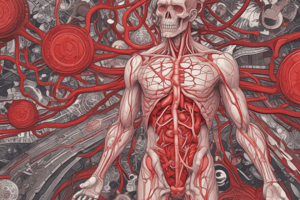Podcast
Questions and Answers
What happens to enzymes when the temperature exceeds 45°C?
What happens to enzymes when the temperature exceeds 45°C?
- They enhance blood flow regulation.
- They promote heat retention in cells.
- They function optimally, increasing metabolic rates.
- They become inactive due to denaturation. (correct)
How do blood vessels respond to a drop in temperature below the set core temperature?
How do blood vessels respond to a drop in temperature below the set core temperature?
- They cause muscle relaxation to warm up.
- They dilate to increase heat loss.
- They restrict blood flow to conserve heat. (correct)
- They remain unchanged to maintain blood pressure.
What is the primary function of sweat glands during elevated temperatures?
What is the primary function of sweat glands during elevated temperatures?
- To conserve water within the body.
- To promote blood flow to the brain.
- To facilitate heat loss through evaporation. (correct)
- To increase internal body temperature.
Which hormone is primarily responsible for lowering blood glucose levels?
Which hormone is primarily responsible for lowering blood glucose levels?
What adverse effect occurs to cells at temperatures below freezing point?
What adverse effect occurs to cells at temperatures below freezing point?
What role do effectors play in a feedback loop?
What role do effectors play in a feedback loop?
Which component of a feedback loop is responsible for monitoring changes in physiological parameters?
Which component of a feedback loop is responsible for monitoring changes in physiological parameters?
What is the primary function of the Control Center in a feedback loop?
What is the primary function of the Control Center in a feedback loop?
Which of the following statements is true regarding feedback loops in the body?
Which of the following statements is true regarding feedback loops in the body?
What characterizes negative feedback in physiological systems?
What characterizes negative feedback in physiological systems?
If the Control Center detects that a physiological parameter is too far from the set point, what is the most likely action it will take?
If the Control Center detects that a physiological parameter is too far from the set point, what is the most likely action it will take?
In which scenario would positive feedback be more likely to occur?
In which scenario would positive feedback be more likely to occur?
What is the primary function of feedback loops in maintaining homeostasis?
What is the primary function of feedback loops in maintaining homeostasis?
Which of the following statements is true regarding feedback mechanisms?
Which of the following statements is true regarding feedback mechanisms?
How does the body generally respond when a stimulus increases?
How does the body generally respond when a stimulus increases?
What role does insulin play in glucose regulation?
What role does insulin play in glucose regulation?
In what circumstance does glucagon release glucose into the bloodstream?
In what circumstance does glucagon release glucose into the bloodstream?
Which of the following statements about glycogen is correct?
Which of the following statements about glycogen is correct?
How does the body respond to an increase in blood glucose levels after eating?
How does the body respond to an increase in blood glucose levels after eating?
Which cellular response occurs when blood glucose levels are low?
Which cellular response occurs when blood glucose levels are low?
Flashcards
Feedback Loop
Feedback Loop
A process that helps the body maintain a stable internal environment. It involves a loop where the system responds to changes, reversing any significant deviation from the normal range.
Negative Feedback
Negative Feedback
A type of feedback mechanism that counteracts a change in the body. It works to reverse the initial stimulus and restore balance.
Positive Feedback
Positive Feedback
A type of feedback mechanism that amplifies a change in the body. It works to increase the initial stimulus, pushing the system further away from balance.
Effector
Effector
Signup and view all the flashcards
Sensor
Sensor
Signup and view all the flashcards
Control Center
Control Center
Signup and view all the flashcards
Thermoregulation
Thermoregulation
Signup and view all the flashcards
Hypothalamus
Hypothalamus
Signup and view all the flashcards
Blood Flow Redirection (Cold)
Blood Flow Redirection (Cold)
Signup and view all the flashcards
Blood Flow Redirection (Hot)
Blood Flow Redirection (Hot)
Signup and view all the flashcards
Shivering
Shivering
Signup and view all the flashcards
What happens to excess glucose in the body?
What happens to excess glucose in the body?
Signup and view all the flashcards
What is insulin's role in blood sugar regulation?
What is insulin's role in blood sugar regulation?
Signup and view all the flashcards
What is glucagon's role in blood sugar regulation?
What is glucagon's role in blood sugar regulation?
Signup and view all the flashcards
How does blood glucose regulation work?
How does blood glucose regulation work?
Signup and view all the flashcards
What is glycogen?
What is glycogen?
Signup and view all the flashcards
Study Notes
Course Information
- Faculty of Medicine
- Academic Year: 2024-2025
- Year: 1
- Semester: 1
- Module: Human Body Function (HBF) 102
Physiology of Homeostasis
- Defined as the body's ability to maintain a stable, relatively constant internal environment despite external fluctuations.
- Homeostasis is crucial for all living organisms.
- Homeostasis helps maintain constant internal conditions such as temperature, glucose, potassium and others.
- The body shivers as an example to maintain a relatively constant body temperature in cold environments.
- The normal range of body temperature is between approximately 36.5-37.5°C (97.7-99.5°F).
Objectives
- Define and discuss the concept of homeostasis and its importance to living organisms.
- Discuss how physiologic control mechanisms maintain the body's normal steady state.
- Define a feedback mechanism and describe its components.
- Differentiate between positive and negative feedback mechanisms and give examples.
Pathophysiology
- Disruption of homeostasis leads to disease.
- Failure of homeostasis can result in death.
Control Systems
- Nervous System: Controls rapid body responses. It detects and initiates reactions to changes in the environment, such as regulating blood pressure.
- Endocrine System: Regulates activities that require duration, such as hormone regulation of calcium levels and control of blood glucose. Examples include parathyroid hormones, thyroid hormones and insulin.
Feedback Loops
- Control Centers: Found in the brain, these centers play a vital role in regulating physiological parameters.
- Feedback Loops: Continuously monitor and adjust conditions in the body to maintain homeostasis. This process is crucial to return the body to its normal state by restoring physiological parameters.
- Example: The body's response to temperature changes to maintain a set point.
Feedback Mechanisms
- Positive Feedback: Action is in the same direction as the stimulus. Continuously reinforces a change in the system, resulting in further change (e.g. blood clot formation, childbirth)
- Negative Feedback: Action in the opposite direction to the stimulus. Counteracts the change, returning the system to its previous state, in order to prevent severe outcomes. (e.g. regulation of blood glucose, body temperature)
Types of Feedback Mechanisms
- Negative Feedback: The effector's response is opposite to the stimulus, maintaining homeostasis. Most body systems use negative feedback (e.g., blood glucose levels).
- Positive Feedback: The effector's response is in the same direction as the stimulus and is often only needed for specific outcomes or until an endpoint is reached (e.g., blood clotting, childbirth).
Feedback Loops Components
- Sensors/Receptors: Monitors internal conditions and report changes to the control center.
- Control Center: Receives sensory input, compares to the set point, and sends signals to effectors.
- Effectors: Executes the command to change internal conditions. Example includes muscles and glands.
Temperature Regulation
- The body maintains its core temperature (thermoregulation) through negative feedback mechanisms between 36.5-37.5°C (97.7-99.5°F).
- The hypothalamus plays a crucial role as a body thermostat.
- The body reacts to maintain temperature when it exceeds a set core temperature. For higher temperature, it dilates blood vessels to allow more heat loss through the skin, sweat to evaporate.
- When temperature is too low, blood vessels constrict to reduce heat loss, and shivering generates heat within the body.
Blood Glucose Regulation
- The pancreas regulates blood glucose levels through insulin and glucagon.
- High blood glucose triggers insulin release, promoting removal of glucose from blood to storage as glycogen in liver cells.
- Low blood glucose triggers glucagon release from pancreas to stimulate liver cells to release glucose.
Diabetes
- Diabetes occurs when the body does not produce enough insulin, causing glucose levels to remain elevated.
- Diabetics need to inject insulin to regulate glucose levels.
Blood Pressure Regulation
- Baroreceptors monitor blood pressure.
- When blood pressure rises: blood vessels dilate to reduce blood pressure.
- When blood pressure falls: blood vessels constrict and cardiac output increases.
Calcium Regulation
- The thyroid gland regulates calcium through calcitonin.
- When calcium levels rise: calcitonin is released to promote calcium deposition in bones.
- When calcium levels fall: parathyroid hormone (PTH) is released to promote calcium release from bones.
Kidney and Water Regulation
- The nephrons in kidneys filter nutrients to maintain water balance.
- Antidiuretic hormone (ADH) is crucial for water balance.
Positive Feedback Loops
- Positive feedback mechanisms amplify changes within a system, moving it farther from its normal range (e.g., childbirth, blood clotting.). -These mechanisms are critical for specific and rapid processes like blood clot formation, but they are not for general homeostasis.
- In most cases, a mechanism like a counter-signal stops or suppresses the loop once the purpose has been fulfilled (e.g., childbirth, lactation).
Studying That Suits You
Use AI to generate personalized quizzes and flashcards to suit your learning preferences.





